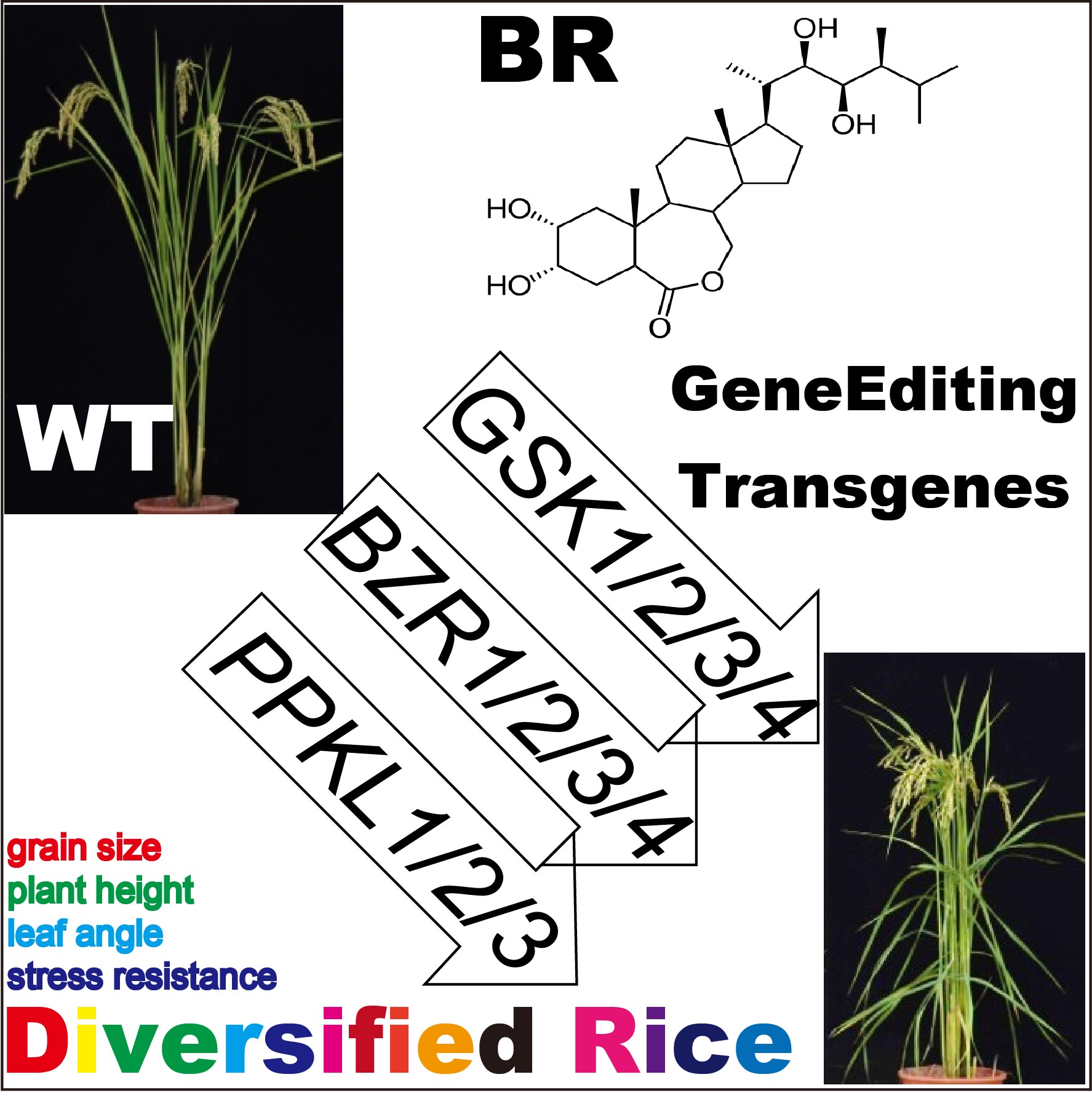 精选
精选
水稻育种逐渐进入分子设计阶段,迅速发展的基因编辑技术为不同性状的定向改良提供了可能,然而其实际应用仍存在局限性。即便面对同一性状,不同育种家不同品种在不同生态区面对不同消费人群,其改良需求也是不同的。因此,如何满足多样化动态需求成为当前分子设计育种的一大挑战。油菜素甾醇(BR)显著调控水稻株型、粒型和耐逆性等诸多重要农艺性状,在作物遗传改良及分子设计上具有巨大应用潜力。然而,由于不同性状之间的复杂关联,利用BR针对某一性状改良往往伴随有负效应,克服这一问题对有效利用BR基因进行分子设计具有重要意义。
刘大普博士等采用单载体多靶标或针对保守序列等不同策略,利用CRISPR/Cas9基因编辑技术分别对BR主信号通路的三个基因家族成员(GSK1-GSK4, OsBZR1-OsBZR4, PPKL1-PPKL3)进行了混合敲除,获得了一系列不同组合、不同位点的突变体,包含了丰富多样的性状组合,可筛选获得各种性状特异或多种优异性状组合的遗传材料,为利用BR基因进行分子设计以满足不同改良需求提供了新思路。此外,该研究还创制了BR信号通路中代表性基因GSK2、BZR和PPKL等野生型或激活形式融合不同蛋白标签(GFP, Flag, Myc)的过表达材料并进行了分子验证,为后续BR相关研究奠定了坚实的材料基础。
该项工作于2021年8月17日以“Diversification of Plant Agronomic Traits by Genome Editing of Brassinosteroid Signaling Family Genes in Rice”为题在线发表在Plant Physiology杂志。刘大普博士、于智坤和张国霞博士为共同第一作者,童红宁研究员、储成才研究员、王士梅研究员为共同通讯作者。
课题组发表相关文章:
1. Liu D#, Yu Z#, Zhang G#, Yin W, Li L, Niu M, Meng W, Zhang X, Dong N, Liu J, Yang Z, Wang S*, Chu C*, Tong H* (2021) Diversification of plant agronomic traits by genome editing of brassinosteroid signaling family genes in rice. Plant Physiol. Doi: 10.1093/plphys/kiab394.
2. Li Q, Xu F, Chen Z, Teng Z, Sun K, Li X, Yu J, Zhang G, Liang Y, Huang X, Du L, Qian Y, Wang Y, Chu C*, Tang J* (2021) Synergistic interplay of ABA and BR signal in regulating plant growth and adaptation. Nat. Plants. 7: 1108–1118.
3. Li G, Tang J, Zheng J*, and Chu C* (2021) Exploration of rice yield potential: Decoding agronomic and physiological traits. Crop J. 9(3): 577-589. (Invited Review)
4. Liu Y#, Wang H#, Jiang Z, Wang W, Xu R, Wang Q, Zhang Z, Li A, Liang Y, Ou S, Liu X, Cao S, Tong H, Wang Y, Zhou F, Liao H, Hu B*, and Chu C* (2021) Genomic basis of geographical adaptation to soil nitrogen in rice. Nature 590: 600-605.
Highlighted by Wei Li (2021) Adaptation to Nitrogen. Nature Genetics. 53(2): 127.
Spotlighted by Bing Wang and Jiayang Li (2021) Rice Geographic Adaption to Poor Soil: Novel Insight in Sustainable Agriculture. Molecular Plant. 14: 369-371.
Featured by Alisdair Fernie (2021) Using landrace transcription factor alleles to increase yield in modern rice under low input agriculture. Journal of Plant Physiology. 258-259: 153362.
Commented by Xianran Li and Jianming Yu (2021) Retrofitting elites with ancestral alleles for sustainable agriculture. Science China Life Sciences. 64(6):1029-1030.
Mini-reviewed by Fanmiao Wang, Hideki Yashida and Makoto Matsuoka (2021) Making the “Green Revolution” Truly Green: improving crop nitrogen use efficiency. Plant and Cell Physiology. doi: 10.1093/pcp/pcab051.
热点评述: 宣伟, 徐国华. 植物适应土壤氮素环境的基因选择: 以水稻为例. 植物学报. 56(1)(2021), 1-5.
Selected by F1000Prime by Jian Feng Ma, Jiming Jiang.
5. Xiao Y#, Zhang G#, Liu D, Niu M, Tong H*, and Chu C* (2020) GSK2 stabilizes OFP3 to suppress brassinosteroid responses in rice. Plant J. 102: 1187-1201.
6. Xiao Y, Liu D, Zhang G, Gao S, Liu L, Xu F, Che R, Tong H*, Chu C* (2019) Big Grain3, encoding a purine permease, regulates grain size via modulating cytokinin transport in rice. J. Integr. Plant Biol. 61(5): 581-597.
7. Tong H and Chu C* (2018) Functional specificities of brassinosteroid and potential utilization for crop improvement. Trends Plant Sci. 23(11): 1016-1028. (Invited Review)
8. Xiao Y, Liu D, Zhang G, Tong H*, Chu C* (2017) Brassinosteroids regulate OFP1, a DLT interacting protein, to modulate plant architecture and grain morphology in rice. Front. Plant Sci. 8: 1698.
9. Tong H and Chu C* (2017) Physiological analysis of brassinosteroid responses and sensitivity in rice. Methods Mol. Biol. 1564: 23-29.
10. Tong H and Chu C* (2016) Brassinosteroid regulates gibberellin synthesis to promote cell elongation in rice: Critical comments on Ross and Quittenden’s letter. Plant Cell 28(4): 833-835.
11. Che R#, Tong H#, Shi B, Liu Y, Fang S, Liu D, Xiao Y, Hu B, Liu L, Wang H, Zhao M*, and Chu C* (2015) Control of grain size and rice yield by GL2-mediated brassinosteroid responses. Nat. Plants 2: 15195. [高被引论文]
Featured by Hirokazu Tsukaya (2015) Yield Increase: GRFs Provide the Key. Nature Plants 2: 15210.
Highlighted by Lingtong Liu and Tai Wang (2016): miR396-GRF Modules: A New Prospective on Rice Molecular Breeding. Chinese Bulletin of Botany 51: 148-151.
12. Liu L#, Tong H#, Xiao Y, Che R, Xu F, Hu B, Liang C, Chu J, Li J*, and Chu C* (2015) Activation of Big Grain1 significantly improves grain size by regulating auxin transport in rice. Proc. Natl. Acad. Sci. U S A 112(35): 11102-11107.
13. Tong H#, Xiao Y#, Liu D, Gao S, Liu L, Yin Y, Jin Y, Qian Q, and Chu C* (2014) Brassinosteroid regulates cell elongation by modulating gibberellin metabolism in rice. Plant Cell 26(11): 4376-4393. [高被引论文]
Featured by Nancy R. Hofmann (2015). Taking Hormone Crosstalk to a New Level: Brassinosteroids Regulate Gibberellin Biosynthesis. Plant Cell 25(8):2081.
14. Tong H, Liu L, Jin Y, Du L, Yin Y, Qian Q, Zhu L, and Chu C* (2012) DWARF AND LOW-TILLERING acts as a direct downstream target of a GSK3/SHAGGY-like kinase to mediate brassinosteroid responses in rice. Plant Cell 24(6): 2562–2577.
15. Tong H and Chu C* (2012) Brassinosteroid signaling and application in rice. J. Genet. Genomics 39(1): 3-9.
16. Tong H and Chu C* (2009) Roles of DLT in fine modulation on brassinosteroid response in rice. Plant Sig. Behav. 4 (5): 438 - 439.
17. Tong H, Jin Y, Liu W, Li F, Fang J, Yin Y, Qian Q, Zhu L, and Chu C* (2009) DWARF AND LOW-TILLERING, a new member of GRAS family, plays positive roles in brassinosteroid signaling in rice. Plant J. 58: 803-816.
转载本文请联系原作者获取授权,同时请注明本文来自储成才科学网博客。
链接地址:https://m.sciencenet.cn/blog-2351-1300387.html?mobile=1
收藏



